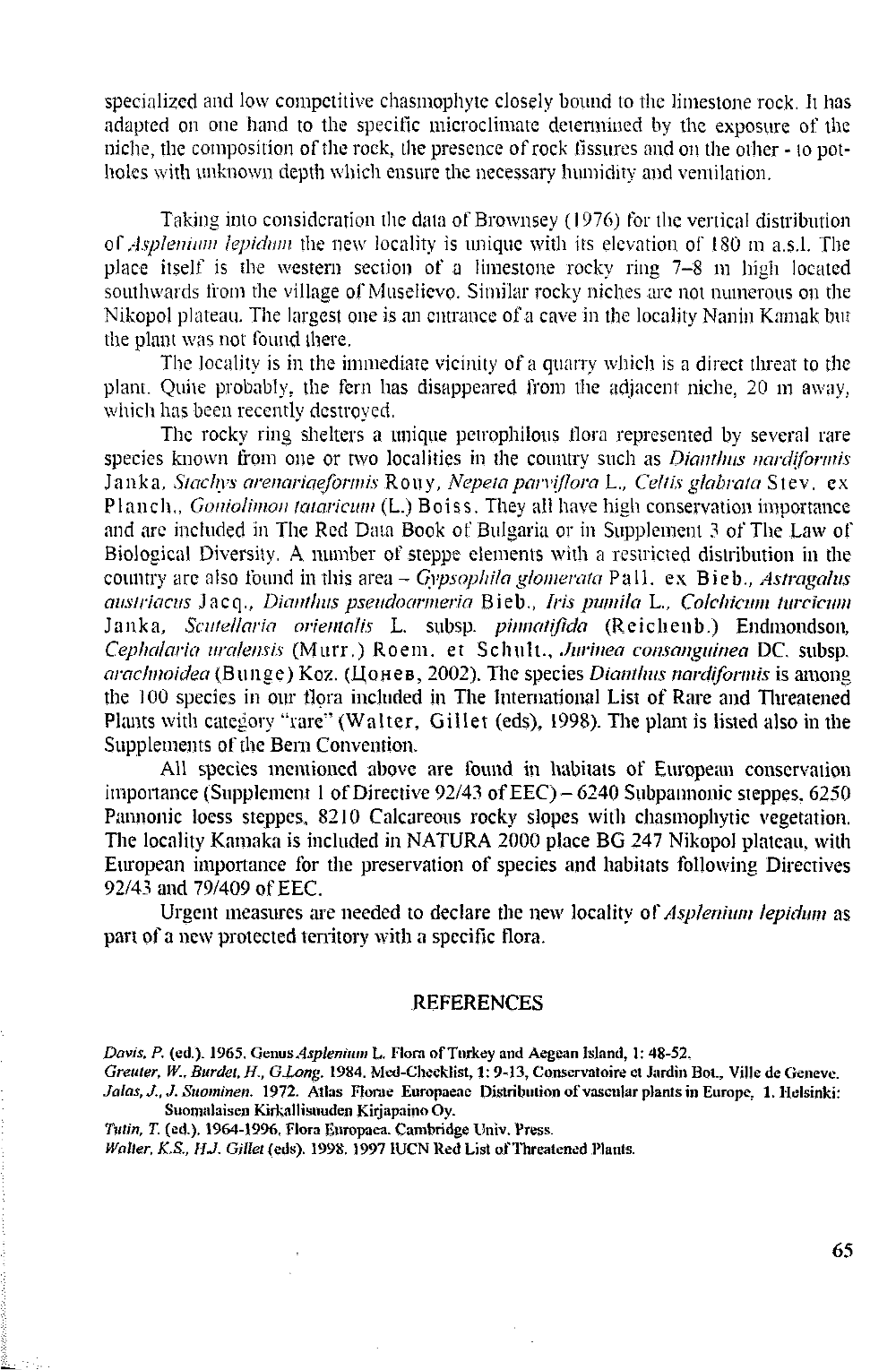

specialized and low competitive chasmophyte closely bound to the limestone rock. It has
adapted on one hand to the specific microclimate determined by the exposure of the
niche, the composition of the rock, the presence of rock .fissures and on the other - to pot
holes with unknown depth which ensure the necessary humidity and ventilation.
Taking into consideration the data of Brownsey (1976) tor the vertical distribution
of
Asplenium lepidum
the new locality is unique with its elevation of 180 m a.s.l. The
place itself is the western section of a limestone rocky ring 7-8 m high located
southwards from the village of Muselievo. Similar rocky niches are not numerous on the
Nikopol plateau. The largest one is an entrance of a cave in the locality Nan in Kamak but
the plant was not found there,
The locality is in the immediate vicinity of a quarry which is a direct threat to the
plant. Quite probably, the fern has disappeared from the adjacent niche, 20 m away,
which has been recently destroyed.
The rocky ring shelters a unique petrophtlous flora represented by several rare
species known from one or two localities in the country such as
Dianthus nardiformis
Janкa,
Stachys arenariaeformis
R о иу ,
Nepeta parviflora
L.,
Celtis glahrata
S tev . ex
Planch,,
GonioHmon lataricum
(L.) B o iss. They all have high conservation importance
and arc included in The Red Data Book of Bulgaria or in Supplement 3 of The Law of
Biological Diversity. A. number of steppe elements with a restricted distribution in the
country are also found in this area -
Gypsophilaglomeraia
P a ll, ex B ieb .,
Astragalus
austriacus
jacq .,
Dianthus pseudoarmerta
B ieb.,
Iris pwnila
L.,
Cohhicum turcicum
Janka,
Scutellaria orientalis
L. subsp.
pinnaiifida
(R eichenb .) Endmondson,
Cephct!aria uralensis
(Murr.) Roem . et Sc hu It.,
Jurinea consanguinea
DC. subsp.
arachnoidea
(Bunge) Koz. (Цонев, 2002). The species
Dianthus nardiformis
is among
the 100 species in our flora included in The International List o f Rare and Threatened
Plants with category “rare'’ (W alter, G ille t (eds), 1998). The plant is listed also in the
Supplements of the Bern Convention.
All species mentioned above are found in habitats of European conservation
importance (Supplement 1 o f Directive 92/43 o fEEC )-6 2 4 0 Subpannonic steppes, 6250
Pannonic loess steppes, 8210 Calcareous rocky slopes with chasmophytic vegetation.
The locality Kamaka is included in NATURA 2000 place BG 247 Nikopol plateau, with
European importance for the preservation of species and habitats following Directives
92/43 and 79/409 of EEC.
Urgent measures are needed to declare the new locality о
i'Asplenium lepidum
as
part of a new protected territory with a specific flora.
REFERENCES
Davis, P.
(ed.). 1965. Genus
.'isplenium
L. Flora of Turkey and Aegean Island, 1: 48-52,
Greuter, IV., Burdet, H., GXong.
1984. Med-Checklist, 1:9-13, Conservatoire et Jardin Bot., Vilje de Geneve.
Jaias,J.,J.Suominen.
1972. Atlas Florae Enropaeae Distribution of vascular plants in Europe. 1. Helsinki:
Suonialaisen Kirkallisuudcn Kirjapaino Oy.
Tytin, T.
(ed.), 1964-1996, Flora Europaea. Cambridge Univ. Press.
m iter, K.S., IIJ. Gillet
(eds). 1998. 1997 1UCN Red List of Threatened Plants.
65
Электронная Научная СельскоХозяйственная Библиотека









